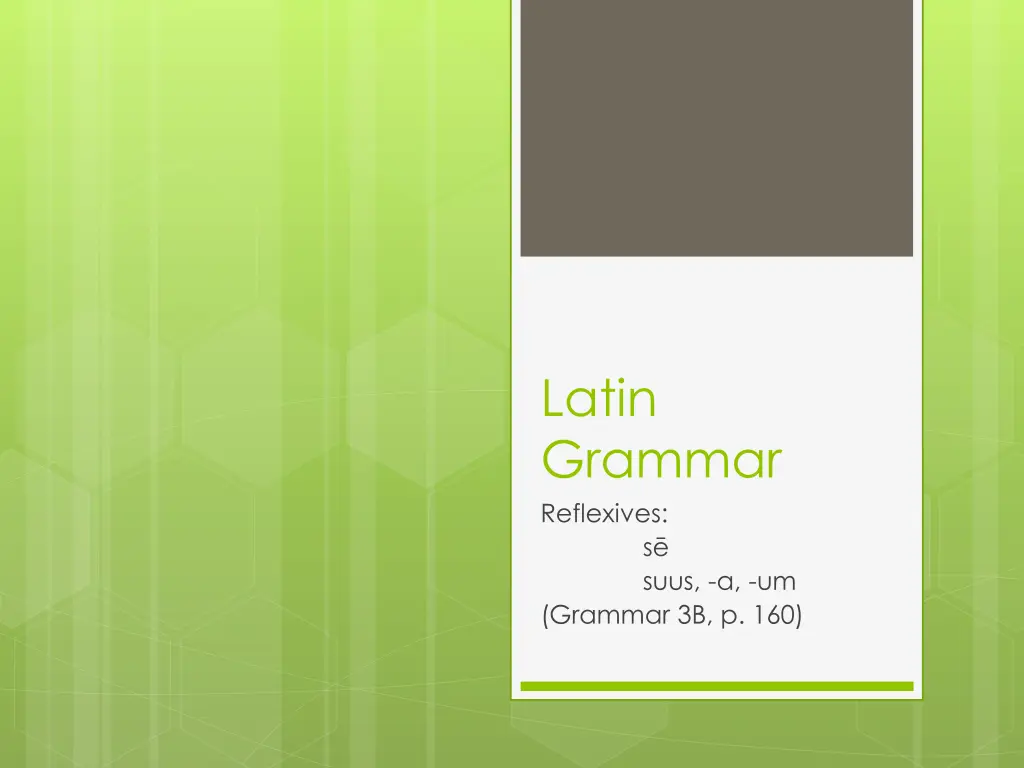
Latin Reflexive Pronouns and Possessives
Explore Latin reflexive pronouns, their usage in English and Latin, examples, and the reflexive possessive adjective "suus, -a, -um". Understand how reflexive pronouns indicate actions reflecting back to the subject in both languages.
Download Presentation

Please find below an Image/Link to download the presentation.
The content on the website is provided AS IS for your information and personal use only. It may not be sold, licensed, or shared on other websites without obtaining consent from the author. If you encounter any issues during the download, it is possible that the publisher has removed the file from their server.
You are allowed to download the files provided on this website for personal or commercial use, subject to the condition that they are used lawfully. All files are the property of their respective owners.
The content on the website is provided AS IS for your information and personal use only. It may not be sold, licensed, or shared on other websites without obtaining consent from the author.
E N D
Presentation Transcript
Latin Grammar Reflexives: s suus, -a, -um (Grammar 3B, p. 160)
Reflexive Pronouns Reflexive pronouns in English end in self or selves. They exist in all three persons and both numbers. SINGULAR myself yourself PLURAL ourselves yourselves themselves 1stPERSON: 2ndPERSON: 3rdPERSON: himself, herself, itself
Reflexive Pronouns Reflexive means bending [flex] back [re]. They are called reflexive pronouns because they indicate that the action of a verb has bent back to affect the subject of a sentence. I love myself. The girls hurt themselves.
Reflexive Pronouns In Latin, the reflexive pronouns look like the normal personal pronouns in the first and second person singular and plural. In the third person singular and plural, Latin s reflexive pronoun is s . SINGULAR m t s PLURAL n s u s s 1stPERSON: 2ndPERSON: 3rdPERSON:
Reflexive Pronouns Examples: I love myself = m am . you love yourself = t am s he loves himself = s amat. she loves herself = s amat we love ourselves = n s am mus y all love yourselves = u s am tis they love themselves = s amant
Declension o f s t t tu tibi t s su sibi s
suus, -a, -um So that is Latin s reflexive pronoun s . We now have to talk about Latin s reflexive possessive adjective suus, -a, -um.
suus, -a, -um Latin s personal pronouns have possessive adjectives associated with them: ego => meus, -a, -um t => tuus, -a, -um n s => noster, nostra, nostrum u s => uester, uestra, uestrum
suus, -a, -um But remember, there is no third person pronoun. And, not surprisingly therefore, there is actually no possessive adjective that means his, her, its, or their. Instead, Romans used the genitive of is, ea, id. (eius in the singular; e rum or e rum in the plural). eius = his, her, its e rum, e rum = their
suus, -a, -um Possessive adectives (meus, tuus, noster, uester) have to agree in gender, case, and number with what they describe. stilum tuum u d . stilus tuus est in aedibus. However, because the words for his, her, and their are NOT possessive adjectives in Latin, they never change to agree in gender, case and number. stilum eius uid . stilus eius est in aedibus.
suus, -a, -um The reflexive pronoun, however, does have a possessive adjective. It is suus, -a, -um, and it must agree with what it describes. Marcus suum patrem u dit, Iulia su s sor r s u dit.
suus, -a, -um IMPORTANT POINT In Latin, you must distinguish between the reflexive possessive and the genitive forms eius, e rum, e rum. Marcus patrem suum u dit Marcus patrem eius u dit.
suus, -a, -um In English, this statement is ambiguous: John saw his father Is his father John s father or someone else s? In Latin, you must distinguish between the reflexive possessive and eius, e rum, e rum. Marcus patrem suum u dit Marcus patrem eius u dit.

